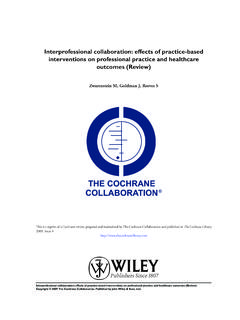Transcription of C enter for E ffective P ublic P olicy - Collaborative …
1 Center for Effective Public Policy The importance of Collaborative leadership in Achieving Effective Criminal Justice Outcomes By Madeline M. Carter Revised January 2006 What Does it Mean to be a Great Leader? Lessons from the Orchestra Roger Nierenberg, symphony conductor of Connecticut s Stamford Symphony Orchestra, leads a program for management executives called The Music Paradigm. 1 What can leaders and teams learn from a conductor? Imagine for a moment that you are sitting in a great music hall. The conductor leads her orchestra in beautiful harmony. How is this done? Nierenberg says, A leader defines for the team what kind of moment they re in. Is this a moment of transition? Is this a dangerous moment? Your job as conductor is to get the orchestra to act together powerfully.
2 So what do you do? You can t be calling out to people, Act now! Act now! That creates disorder. Instead, you say, Here's where we're headed. 2 Lesson #1: Effective Leaders Are Clear About Their Goals. A leader, according to Nierenberg, is someone who commits to what has yet to happen. How can leaders do this? Good leaders know where the team is going. They are able to articulate where the team s work is headed, and why the goal is important. Like a conductor, as a leader, you stand on a podium and therefore have access to the big picture. Things that are amazingly obvious from the podium are not at all clear from the chair. Your job as a leader is to communicate a sense of how things could be and to show people how to achieve that vision. 3 This document was developed under grant number SJI-99-N-039-U03-1 from the State Justice Institute.
3 The points of view expressed are those of the authors and do not necessarily represent the official position or policies of the State Justice Institute. 1 1 Rosenfeld (2001). 2 Ibid. 3 Ibid. Lesson #2: Effective Leaders Give Their Team Members Permission to Excel. Good leaders, notes Nierenberg, give people permission to be their best. People are often capable of a much higher level of performance than they exhibit; what often stands in the way is they have failed to receive the green light from the podium. When selected properly, the right team members can do great things. But they must know that they have permission to do so; that the expectation is to explore the bounds of the possible, not to sit in their seats and perform with mediocrity.
4 Lesson #3: Effective Leaders Provide Direction, Not Criticism. Leaders not only have access to the big picture, they also command significant influence over the direction of their team s efforts. When a team is underperforming, its leader stands in a unique position to motivate others to work towards their goal. Effective leaders can redirect the effort using guidance rather than criticism. Direction points to the way things could be. Criticism, on the other hand, points to the way things were. 4 Good leaders know the way; great ones lead the way. Why is leadership Important to the Effectiveness of Justice-Related Collaboratives? Lesson #4: Successful Justice System Collaboratives Depend on Effective leadership . Justice system professionals are increasingly called upon to collaborate in an effort to more effectively address the challenging issues facing 4 Ibid.
5 The criminal and juvenile justice systems today. Issues as complex as poverty, substance abuse, domestic violence, and mental illness all seemingly manifest themselves in the jail lock-up, courtroom, treatment group, and parole office. Because our law enforcement officials, judges, prosecutors, defenders, advocates, and corrections professionals are specialists and experts in their own right and in their own field, collaboration becomes essential to bring to the table the expertise necessary to adequately address these complex social justice problems if we are to have any hope of increasing the safety of our communities through crime prevention and recidivism reduction. For good reason, much attention is paid to the role of the team as a whole in carrying out its mutually established vision, mission, and goals, whether the vision is a more efficient justice system through expedited case processing, primary crime prevention strategies, the reduction of recidivism through enhanced assessment and delivery of evidence-based interventions, or increased family support in juvenile justice cases through specialized courtroom, advocacy, and support programs.
6 Less focus is typically paid to the leader on the team, perhaps because the act of singling out and emphasizing the role of one individual over the other team members somehow diminishes the importance of the others, or contradicts the notion of equality that is so central to Collaborative teams. And yet, the critical role of the team leader is undeniable. Indeed, when Carl Larson and Frank LaFasto studied the work of groups from fields as diverse as business, sports, community development, and public health in order to determine what makes teams succeed, the presence of leadership was among the most important characteristics of effective Distinguishing Management from leadership Lesson #5: Management and leadership Are Not the Same. In thinking about the role of leaders, we often confuse the terms management with leadership .
7 Peter Drucker and Warren Bennis distinguish these terms by 5 Larson and LaFasto (1989). noting that Management is doing things right, leadership is doing the right things. 6 Qualities that have long been viewed as characteristics of effective criminal justice leaders ( , those who are tough but fair, efficient, consistent, or decisive, to name but a few) do not necessarily guarantee that these same individuals have the qualities necessary to successfully lead a Collaborative team. Having the necessary skills to manage an agency does not equate to successfully leading an orchestra. Distinguishing leadership Roles from leadership Skills Lesson #6: Good Managers Are Not Necessarily Good Leaders. Collaborative leaders are therefore not necessarily those who occupy the positions of agency director, chief judge, or key community leader.
8 These are positional leaders. Individuals may also serve as situational leaders by being asked (or self-appointed) to serve in a leadership role for a specific purpose or period of time. These positional and situational leaders may or may not be effective Collaborative leaders. If they are, it is because of their unique skills, not because of the positions they hold. In both situations, the role of leadership must be distinguished from the skills of leadership . While occasionally these are found in the same individual, this is not always the case. Defining Collaborative leadership In their work Collaborative leadership , Chrislip and Larson (1994) describe Collaborative leadership in the following way: ..Leaders are those who articulate a vision, inspire people to act, and focus on concrete problems and results.
9 [But] collaboration needs a different kind of leadership ; it needs leaders who can safeguard the process, facilitate interaction, and patiently deal with high levels of frustration. 6 See: 2 Collaboration works when .. keep the process going. 7 Because leadership in the Collaborative environment is entirely different from hierarchical (positional or situational) leadership Collaborative leaders guide rather than control, motivate rather than direct. Effective Collaborative leaders are individuals who possess a unique and critically important set of qualities and skills. Common Qualities of Effective Collaborative Leaders Lesson #7: leadership is Not a Mystery; Collaborative Leaders Share Common Qualities. A review of the literature as diverse as that produced by the New Center for Collaborative leadership , Steven Covey and other organizational consultants, and the National Institute of Corrections on correctional leadership , produces a remarkably similar list of qualities of effective leaders.
10 In general, Collaborative leaders are considered to be those who are: Willing to Take Risks. Great leaders are dissatisfied with the status quo and business as usual. They are willing to take risks that hold the promise of positive change. They encourage team members to seek out new solutions, to consider alternatives to the norm, and to embrace the potential of change. As management consultant Tim McMahon says, Yes, risk-taking is inherently failure-prone. Otherwise, it would be called sure-thing taking. Great leaders are not afraid to take risks; they understand that the benefits of success outweigh the setbacks that may be encountered along the way. Eager Listeners. Great leaders are open to all viewpoints. They do not dismiss new ideas as far-fetched, random, or uninformed.




